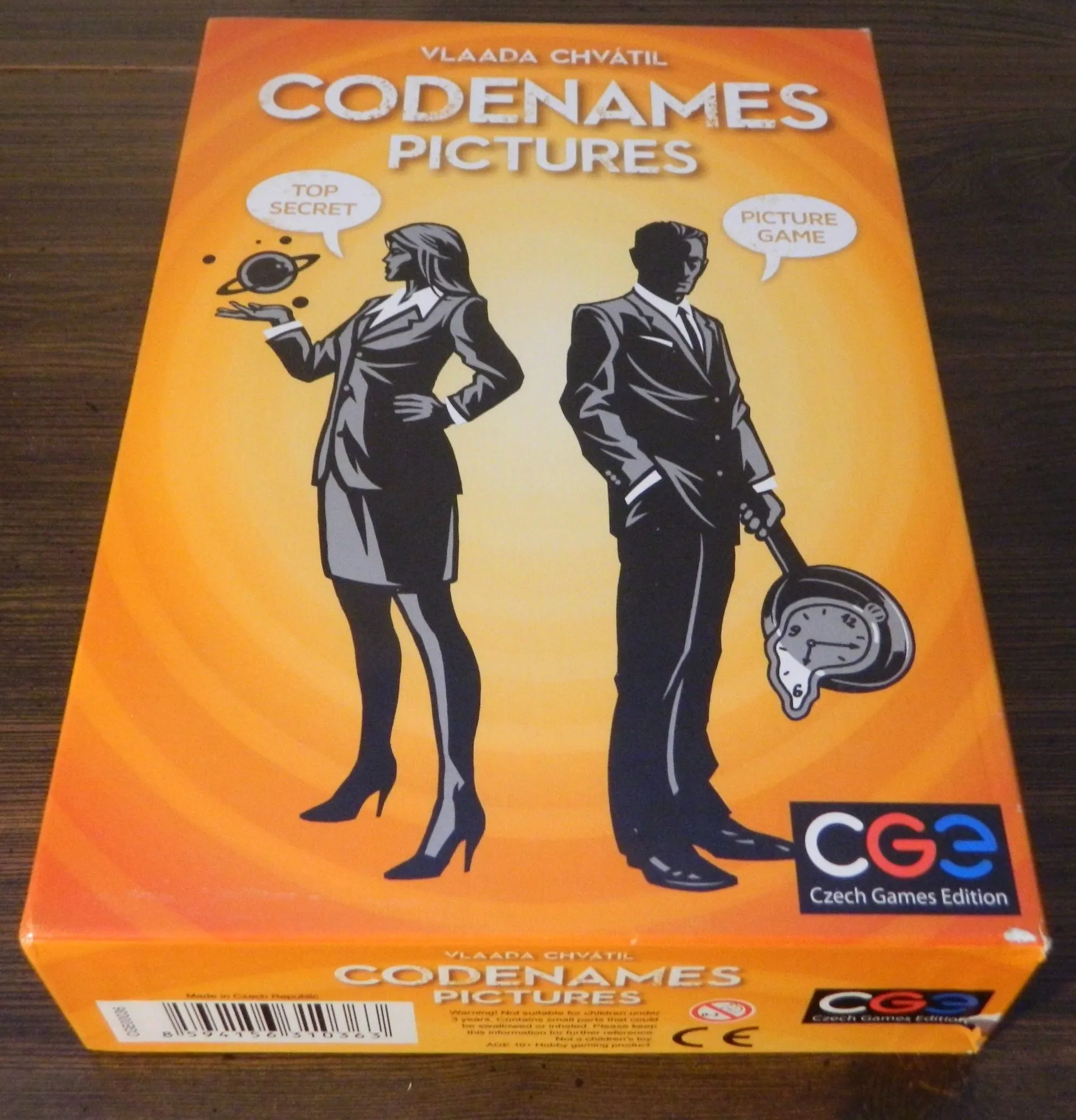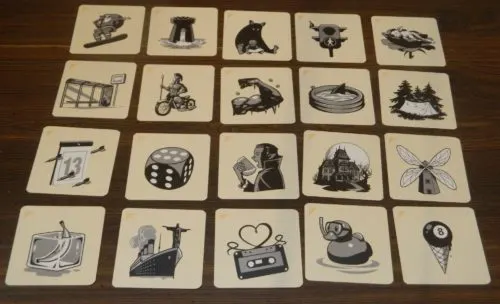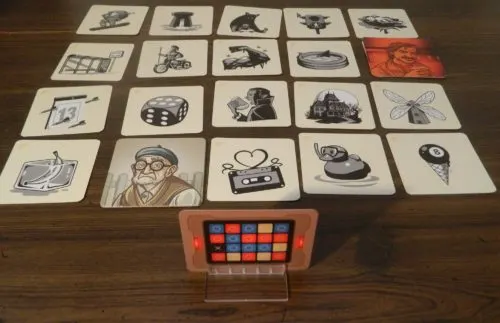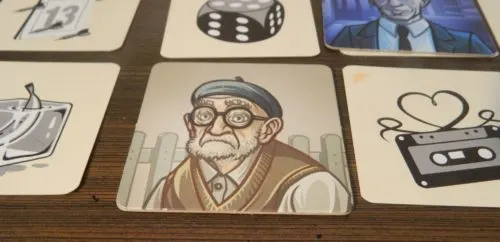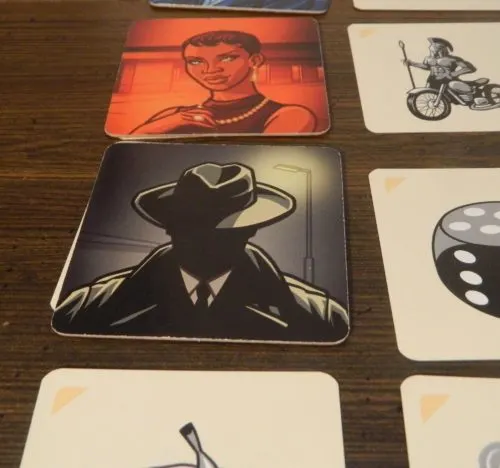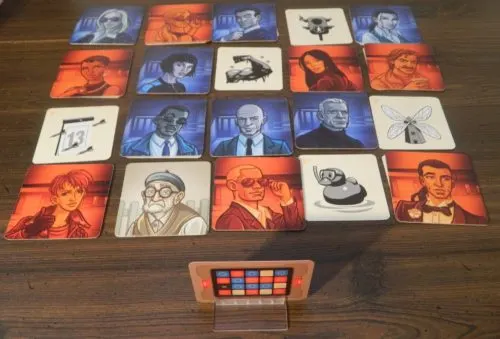About a year ago I took a look at the party game Codenames. Codenames was originally created back in 2015 by Vlaada Chváti. The game was so successful that it ultimately won the 2016 Spiel Des Jahres (game of the year). While I knew that I was going to like Codenames, I was genuinely surprised that the game somehow found a way to surpass my already high expectations. At this point I have played around 800 different board games and I would have to say that Codenames is probably one of my top five favorite board games of all time. That is quite a compliment in my opinion. While not quite perfect Codenames is as close to a perfect game that you could find. I enjoyed Codenames so much that I quickly checked out the two player version of the game, Codenames Duet. Today I am checking out another of the spinoff games, Codenames Pictures. The title is pretty self explanatory as the game is basically Codenames where the word cards have been replaced by pictures. Codenames Pictures is another fantastic party game in the Codenames lineup that is a blast to play but doesn’t quite reach the level of the original game.
How to Play Codenames Pictures
As Codenames Pictures is very similar to the original Codenames, if you are familiar with the original game you can skip to the What’s New section for the additional rules you need to know for Codenames Pictures.
Setup
- The players will divide into two teams. The teams don’t need the same number of players but each team needs at least two players.
- Each team will choose one player to be the spymaster. The rest of the players will be the field operatives. The spymasters from both teams should sit next to one another on one side of the table.
- Randomly choose 20 of the pictures and place them into a 5 x 4 grid on the table. The symbol in the top right of the cards shows which side of the card is the top.
- The spymasters randomly choose one of the key cards and place it in the stand.
- Separate the agent cards based on their colors. Each team chooses a color and the spymaster takes the agent cards corresponding to the chosen color. The bystander and assassin cards are placed between the two spymasters.
- The color on the side of the chosen key card determines which team starts the game. The starting team’s spymaster takes the double agent card (red on one side and blue on the other) as they will have to find one additional agent during the game.
Playing the Game
At the beginning of the game the two spymasters will study the key card. The squares on the key card correspond to the picture cards in the same spaces in the grid. Red squares indicate agents for the red team. Blue squares show the location of blue agents. Pale squares are bystanders and the black square is the location of the assassin.
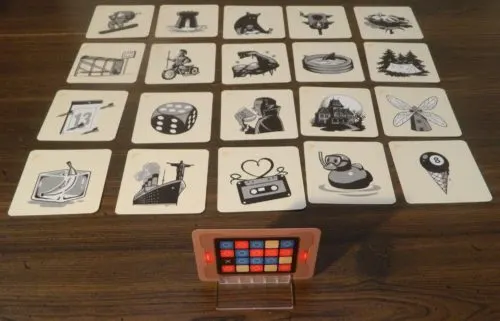
For this code card the assassin is on the darts/calendar picture. The blue team will need to pick the left, middle and right card in the top row; the second card from the left in the second row; and the second, third and fourth card from the left in the third row. The red team has to pick the second card from the left in the first row; the first, third, fourth and fifth cards in the second row; and the first, third, and fifth card in the bottom row.
After studying the key card, the first spymaster will give a clue to their teammates. The spymaster tries to come up with a clue that gets their teammates to pick the cards corresponding to their color while avoiding the other team’s color, the bystanders and definitely the assassin. When the spymaster gives their clue they will give a one word clue and a number which indicates how many of their team’s cards that the clue applies to. The following rules must be followed when giving clues:
- All clue words can only be one word. The clues cannot use hyphens or spaces. If all of the players agree, this rule can be relaxed to allow two or more words that are commonly associated with one another.
- Unlike normal Codenames, you may give a clue by naming exactly what is pictured on the card.
- A player can use a clue word that has several meanings to apply to multiple cards.
- The spymaster can choose to spell out their word clue if they think that will help clarify their clue. If a player asks for the word to be spelled, the spymaster must spell out the clue.
- You may not use a clue word that corresponds to something other than the pictures themselves. For example you can’t use a clue corresponding to the location of a card(s). You also can’t make clues based on the letter that the picture starts with.
- Spymasters cannot give any additional information to their teammates outside of the clue and the number of cards it applies to. The player cannot say any other words, make facial expressions, or make other gestures to help their teammates.
After the clue is given, the spymaster’s teammates analyze the cards to determine which card(s) they think the clue applies to. They will then choose one of the cards and point to it. The spymaster will reveal whether they were right or wrong by placing an indicator card on the chosen picture card.
- Own Agent: The spymaster will place one of their agent cards on the picture card. The spymaster’s teammates can then make another guess if they would like to. Players can make as many guesses as the number given in the clue plus one. The spymaster cannot give them any more clues though. The players can stop making guesses whenever they choose.
- Opponent’s Agent: The spymaster will place one of the other team’s agent cards on the chosen picture. As the players guessed incorrectly, play passes to the other team.
- Innocent Bystander: If the players picked one of the innocent bystanders, their spymaster will place one of the bystander cards on the chosen card. The team’s turn will then end.
- Assassin: If the players choose the assassin card, the card is covered by the assassin card. By revealing the assassin, this team automatically loses the game (unless they are playing with the Assassin Ending variant rule).
End of Game
Codenames Pictures can end in one of two ways.
If a team reveals the assassin, their team immediately loses the game.
If all of the agents from one of the teams are revealed (can be done on the other team’s turn), that team wins the game.
What’s New
If you have played the original Codenames there are three new rules you need to be aware of:
- The grid in Codenames Pictures is a 5 x 4 instead of the 5 x 5 in the original Codenames.
- The rules regarding clues in Codenames Pictures is more relaxed. While you can’t repeat a word found on any of the cards in the original game, you can use the exact word of what is pictured in one of the cards in Codenames Pictures.
- While not used in the normal game, Codenames Pictures also introduces the Assassin Ending variant rule.
Variant Rules
There are four variant rules you can use while playing Codenames Pictures.
Assassin Ending: In the Assassin Ending variant, the game does not end until someone has found the assassin. Players should strive to find all of their own agents and then find the assassin as their last card. If a team is successful in doing this, they win the game.
If a team finds the assassin before they have found the rest of their agents, the game enters a sudden death mode. The players from the team that just found the assassin can keep guessing but they receive no new clues. The players can keep guessing until they guess an agent from the other team or one of the innocent bystanders. If they find all of their agents, they will win the game. If they can’t find all of their agents though, the other team wins the game.
Unlimited Clues: Instead of giving their teammates a specific number to go with their clue, a spymaster can use unlimited. This allows their teammates to make as many guesses as they would like.
Zero Clue: A spymaster is allowed to use 0 for their number clue. If a spymaster uses 0, it means none of their agents match the clue word given. By giving a 0 clue, their teammates can make as many guesses as they want.
Two Player/Cooperative Game: In the two player/cooperative game, there will only be one team playing the game. The spymaster will be giving clues to all of the other players. The other team’s turn is simulated by the spymaster placing one of the other team’s agent cards on a corresponding agent each time the other team would normally have a turn. The game is scored based on how many agent cards for the other team haven’t been found when the players find their last agent.
My Thoughts on Codenames Pictures
If the name didn’t already make it pretty clear, Codenames Pictures is pretty much exactly what you would expect it to be. Outside of a couple slight differences, Codenames Pictures’ gameplay is exactly the same as the original Codenames. The main difference between the two games is that the word cards have been replaced by pictures. As I looked at the original Codenames around a year ago, I don’t really want to waste time repeating what I mentioned in the review of the original game. Basically Codenames is a fantastic party game that works really well because it is so straightforward and yet gives players quite a challenge as they try to give clues that apply to multiple cards. Outside of a couple minor issues, the original Codenames is close to a perfect board game that I would recommend to almost anyone. If you want to learn more about what makes the original Codenames so great, you should check out my review.
Instead of just repeating what I mentioned in the other review, I instead want to talk about what is unique about Codenames Pictures. The obvious difference between the two games is that the word cards have been replaced with pictures. When I first heard about Codenames Pictures I thought this was an interesting idea but I didn’t know how much pictures would actually add to the experience. I thought the game would basically play the same as players would just associate a word with each picture and then just describe that word.
That initial impression was wrong mostly due to the artwork itself. I originally thought the artwork was going to be pretty basic where a card for example would picture a dog. I couldn’t be more wrong as none of the pictures in the game are nearly this simple. What makes Codenames Pictures unique is the fact that all of the pictures are pretty abstract. For example one of the cards in the first game I played initially looked like a snake charmer. When you look closer though, it turns out that the snake in the picture is actually a belt. Basically all of the pictures in the game are like this where multiple different items are combined together to create each card. While some of the artwork is really out there, the artwork in the game is fantastic.
You might initially think the game just decided to go with a weird art style but this art style is actually quite important to the gameplay itself. The initial reason why I was a little hesitant about Codenames Pictures is that I thought each picture was just going to be pretty generic showing only one item. I thought this was going to hurt the Codenames format as it would be hard to formulate clues that applied to several of your cards at the same time. The reason the strange pictures are key to the gameplay is that they give players a lot of different things to work with while coming up with clues. For example there are only a limited amount of ways that you can combine Santa and other pictures. A snowboarding Santa gives you a lot more options though.
While the gameplay between Codenames Pictures and Codenames is the same on a basic level, when you play the game you notice that the two games have a slightly different feel to them. You have to give the same type of clues in both games but you tend to emphasize different things. Instead of just thinking of a clue that would combine a bunch of words together, you need to analyze pictures to try and find a connecting force. This means each game emphasizes different skills. Players who are good at the original game are likely going to be good at Codenames Pictures as well. Players that struggled with the wordplay of the original game might actually be better at the picture orientated Codenames Pictures.
Like the original Codenames, Codenames Pictures is a great party game. I loved playing the game and the addition of the pictures added more to the game than I was expecting. While I really liked Codenames Pictures, I don’t think it is quite as good as the original game. The two games are pretty close but if I had to choose between them, most of the time I would end up picking the original game. I don’t think this will be the same for all players though. People that are more visual might prefer Codenames Pictures over the original game.
I think the biggest reason why I preferred the original game was the idea that it was easier to create clues that would apply to several cards. One of the most satisfying parts of Codenames is when you are able to successfully complete a clue that gets you four or so cards in a turn. Maybe we just got unlucky with the pictures that were drawn, but it is much harder to create clues that work with several cards in Codenames Pictures. In the original Codenames I could usually come up with a clue that applied to three or more of the cards with a couple smaller clues given at the end of the game. In Codenames Pictures most of the clues ended up only applying to two of the pictures. There were also clues at the end of the game that only applied to one card. As coming up with clues that apply to several cards is one of the best things about the original game, it was a little disappointing that this wasn’t as prevalent in Codenames Pictures.
The other main issue I had with Codenames Pictures over the original game was the idea that the game for some reason decided to make the game’s grid a 5 x 4 versus the 5 x 5 in the original game. I honestly don’t understand this decision. Codenames is not a long game as most games should only take around 15 minutes. Therefore I don’t know why the row was eliminated as it couldn’t have been for time. I don’t like the missing row because I think it is a contributing factor to it being harder to come up with clues that apply to more than two cards. I personally would recommend playing the game with the 5 x 5 grid. The problem is that all of the key cards in the game are for the 5 x 4 grid so you can’t really change the grid to a 5 x 5 unless you want to make your own key cards or use the key cards from the original game.
One of the things that I like the most about the Codenames franchise is that the cards are interchangeable. As all of the games have very similar gameplay, you can use the cards from one game with the cards from one of the other games. You don’t even have to alter the rules to combine the cards from Pictures and the original game. You could either alternate between using words and pictures or you could play games that utilize both types of cards. I think it would be quite interesting playing a game of Codenames with both words and pictures.
The final addition to Codenames Pictures is the Assassin Ending variant rule . Basically the Assassin Ending adds another dynamic to the game. In most games using the variant rule you are going to try and find all of your agents before ultimately finding the assassin. This doesn’t sound like much at first as it would seem like you are just forced to find one additional card. When you are only down to one or two agents left though you might want to consider giving a clue that also includes the assassin. As picking the assassin no longer ends the game you could take more risks at the end of the game as you can keep guessing if your teammates pick the assassin. If a team does pick an assassin before the end of the game, it is kind of interesting to see if the other team can keep guessing correctly until they find all of their agents. Overall I liked the variant. I probably wouldn’t use it all of the time but I think it is a nice addition to the game.
Finally the component quality is quite good just like the original game. The cards are about twice as big as the cards in the original Codenames but are of the same quality. As I mentioned earlier, I really liked the cards’ artwork. Just like the original game, Codenames Pictures contains a lot of cards so you shouldn’t have to use the same cards again for a long time. The game has 140 cards and with the cards being double sided you have 280 different pictures to use in the game. When you mix and match these cards, it is almost impossible to ever play the same game twice. The only real complaint I have with the components is that I wish the game came with key cards that would have supported the 5 x 5 grid as I prefer that over the 5 x 4 grid.
Should You Buy Codenames Pictures?
Like the original Codenames, Codenames Pictures is another fantastic party game. As the name makes it perfectly clear, the only significant difference between the two games is that Codenames Pictures uses pictures instead of the words from the original game. At first I didn’t think this was going to change the game much. The gameplay is still the same but Codenames Pictures has a different feel to it. The game stresses different skills as you try to find connections between the pictures. This is a nice change of pace from the original game but I don’t think it is quite as good as the original game. It is much harder to come up with clues in Codenames Pictures that apply to three or more cards. I also didn’t really care for the game eliminating one of the rows to use a 5 x 4 grid instead of a 5 x 5 grid. While I prefer the original Codenames, Codenames Pictures is still a great game that I would highly recommend. Some people will probably even prefer it over the original game.
If you hate party games or didn’t really care for the original Codenames, I don’t think you will like Codenames Pictures. If you already own Codenames and only thought it was an okay game, I don’t know if it pays to pick up Pictures as well unless you think you would prefer pictures over words. People who love Codenames though should really enjoy Codenames Pictures as well. Also if you like party games and haven’t played Codenames, I would recommend picking up both games as they are both great games.
If you would like to purchase Codenames Pictures you can find it online: Amazon, eBay

